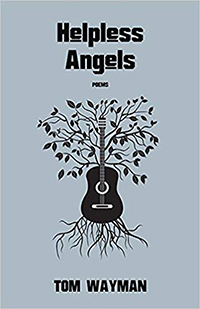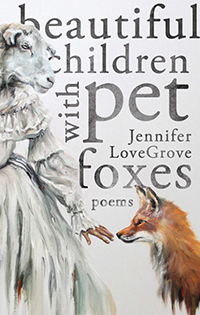Reviews
Poetry Reviews by Dean Steadman
Tom Wayman, Helpless Angels (Saskatoon: Thistledown, 2017). Paperbound, 77 pp., $20.
Jennifer LoveGrove, Beautiful Children with Pet Foxes (Toronto: Book Thug, 2017). Paperbound, 83 pp., $18.
 In his introduction to Helpless Angels, Tom Wayman writes that the collection’s poems “pay tribute to music’s vital and omnipresent contribution to my enjoyment of life: generating in me a sense of happiness, excitement or well-being, or a gained or regained perspective on myself or on some encountered difficulty, or a continued encouragement to work toward a juster, fairer world for us all.” Underlying Wayman’s explication is an appreciation for how music can take us to a heightened level of consciousness where we can experience a sympathetic relationship with the world. In “The Heart Stops, But Never the Music,” Wayman observes: “Music is the laughter of / consciousness / —now pure joy, now / indulgent, now mocking, / regretful, impressed / —always / a communion / with wonder.”
In his introduction to Helpless Angels, Tom Wayman writes that the collection’s poems “pay tribute to music’s vital and omnipresent contribution to my enjoyment of life: generating in me a sense of happiness, excitement or well-being, or a gained or regained perspective on myself or on some encountered difficulty, or a continued encouragement to work toward a juster, fairer world for us all.” Underlying Wayman’s explication is an appreciation for how music can take us to a heightened level of consciousness where we can experience a sympathetic relationship with the world. In “The Heart Stops, But Never the Music,” Wayman observes: “Music is the laughter of / consciousness / —now pure joy, now / indulgent, now mocking, / regretful, impressed / —always / a communion / with wonder.”
As a poet, Wayman is obviously aware that repeated exposure to other art forms can also elevate human consciousness in meaningful and productive ways. But the focus of Helpless Angels is on music and specifically the music of the sixties and seventies when songwriters, such as Fred Neil, Bob Dylan, Richie Havens, Jesse Winchester, and Mentor Williams, to name just a few celebrated in Wayman’s poems, used their art to raise civil awareness and support an ambitious agenda of political and social reform. It was their music, Wayman holds, which helped inspire many in his generation to challenge the status quo and pursue a greater common good. In “Shelby Wall and John Lent Perform 12-Bar Blues at the Upstairs, Vernon, BC,” Wayman writes:
We couldn’t do
nothing.
Here where memory simplifies.
weakens and is gone, we couldn’t stop,
we ascended outward to the dark, it didn’t matter, we
sang.
In the collection’s title poem, Wayman describes the instrumental sounds emanating from a downtown venue into a night rain as “helpless angels / retreating upstream from grief, wrongs, bearing / the sadness aloft.” It is a description equally applicable to the many musicians that he applauds in his poems for their humanity and dedication. There is, however, yet another layer of thematic importance in Wayman’s choice of words. Several poems in the collection allude to works by the poet, Wallace Stevens, and Wayman’s “necessary angels” brings to mind “The Auroras of Autumn” in which Stevens uses the metaphor “necessary angel” to describe the function of poetry: …I am the necessary angel of earth / Since, in my sight, you see the world again.” Wayman’s angels are “helpless” in that they cannot undo the “griefs,” “wrongs,” and “sadness” but, as with Stevens’ “necessary angel,” they are to be celebrated for how their art can raise human consciousness above self-centred complacency to a purposeful level of compassion.
 The mind’s interaction with art is also central to Jennifer LoveGrove’s Beautiful Children with Pet Foxes. Here the poems explore the terra incognita of the twenty-first-century mind where, as the title poem discloses, “weird things keep happening” with perplexing frequency:
The mind’s interaction with art is also central to Jennifer LoveGrove’s Beautiful Children with Pet Foxes. Here the poems explore the terra incognita of the twenty-first-century mind where, as the title poem discloses, “weird things keep happening” with perplexing frequency:
Tonight a fire truck drove by
and the cardboard that was under
my water bottle is missing and I didn’t
What do you think it means
LoveGrove’s style of non-linear phrasing and free-wheeling image and word association captures perfectly the “monkey brain” syndrome, prevalent in this age of information overload, where the mind tends to jump frantically from one branch of thought to another, fueled by addictive technology, media stimulation, and social networking mania. When coupled with the already fragmented psyche born of the existential phenomenon of secularization, it can leave the human mind vulnerable to the trappings of the modern “isms (i.e., solipsism, nihilism, narcissism, individualism, etc.), many of which find expression in LoveGrove’s poems: “What if nothing at all existed?” she asks in “The Stains I Scrubbed from the Floor.”
The experience of feeling alienated in an unmanageable world is central to LoveGrove’s poems. In “Self-Portrait as a Mollusk,” the speaker has transformed, Kafka-like, into a mollusk, unable to articulate her thoughts or see her way forward![]() “…bereft of speech and bone / and the ability to perceive distance.” It is a futile attempt to escape the nightmare of the self in crisis: “I’m trying to rest in this spiral shell, / But last year has snuck in with me.” Memories, like “pet foxes,” can be hard to tame. Yet, tame them we must, for our personal wellbeing and the welfare of society in general. “There was a war going on and / ours was a very important mission,” we are told in “Dream Specimen 227.”
“…bereft of speech and bone / and the ability to perceive distance.” It is a futile attempt to escape the nightmare of the self in crisis: “I’m trying to rest in this spiral shell, / But last year has snuck in with me.” Memories, like “pet foxes,” can be hard to tame. Yet, tame them we must, for our personal wellbeing and the welfare of society in general. “There was a war going on and / ours was a very important mission,” we are told in “Dream Specimen 227.”
It is in this context that LoveGrove reveals our greatest ally to be the experience of art. Whether as artist or art appreciator, our minds have a capacity that can, when cultivated, lift us above the everyday chaos and empower us with a restored sense of wholeness. In “Tasseography,” the penultimate poem in the collection, LoveGrove shares her insight into art’s recuperative strengths: “My grandmother smashes my wineglass / and reads the shards like tea leaves. / She says life is full of flies / and questions and under the dirt, / more dirt.” The grandmother is a practiced, albeit unconventional, seer and artist in her own right, with an ability to replicate her granddaughter’s fragmented perception of reality. She knows the “monkey brain’s” vulnerabilities and the weight of memories on a mind unsupported by the certainty of a containing framework: “She hands me a sack full of rocks / all named after dead strangers, / each painted a different colour: / Famine. Factory. Father. Firing squad.” But the grandmother’s art is also capable of reassembling the fragmented pieces into a new whole, revealing a capacity for a mindfulness that is creative and meaningful: “The glass fragments line up, / sweep themselves into a pile / and reassemble back in her fist.” The grandmother’s fist held tight in a fighting spirit of determination and triumph is a parting image of hope in a troubled and troubling time.
—Dean Steadman









